Xirong Li
Hybrid-Tower: Fine-grained Pseudo-query Interaction and Generation for Text-to-Video Retrieval
Sep 05, 2025Abstract:The Text-to-Video Retrieval (T2VR) task aims to retrieve unlabeled videos by textual queries with the same semantic meanings. Recent CLIP-based approaches have explored two frameworks: Two-Tower versus Single-Tower framework, yet the former suffers from low effectiveness, while the latter suffers from low efficiency. In this study, we explore a new Hybrid-Tower framework that can hybridize the advantages of the Two-Tower and Single-Tower framework, achieving high effectiveness and efficiency simultaneously. We propose a novel hybrid method, Fine-grained Pseudo-query Interaction and Generation for T2VR, ie, PIG, which includes a new pseudo-query generator designed to generate a pseudo-query for each video. This enables the video feature and the textual features of pseudo-query to interact in a fine-grained manner, similar to the Single-Tower approaches to hold high effectiveness, even before the real textual query is received. Simultaneously, our method introduces no additional storage or computational overhead compared to the Two-Tower framework during the inference stage, thus maintaining high efficiency. Extensive experiments on five commonly used text-video retrieval benchmarks demonstrate that our method achieves a significant improvement over the baseline, with an increase of $1.6\% \sim 3.9\%$ in R@1. Furthermore, our method matches the efficiency of Two-Tower models while achieving near state-of-the-art performance, highlighting the advantages of the Hybrid-Tower framework.
Multi-Object Sketch Animation by Scene Decomposition and Motion Planning
Mar 25, 2025Abstract:Sketch animation, which brings static sketches to life by generating dynamic video sequences, has found widespread applications in GIF design, cartoon production, and daily entertainment. While current sketch animation methods perform well in single-object sketch animation, they struggle in multi-object scenarios. By analyzing their failures, we summarize two challenges of transitioning from single-object to multi-object sketch animation: object-aware motion modeling and complex motion optimization. For multi-object sketch animation, we propose MoSketch based on iterative optimization through Score Distillation Sampling (SDS), without any other data for training. We propose four modules: LLM-based scene decomposition, LLM-based motion planning, motion refinement network and compositional SDS, to tackle the two challenges in a divide-and-conquer strategy. Extensive qualitative and quantitative experiments demonstrate the superiority of our method over existing sketch animation approaches. MoSketch takes a pioneering step towards multi-object sketch animation, opening new avenues for future research and applications. The code will be released.
FunBench: Benchmarking Fundus Reading Skills of MLLMs
Mar 02, 2025Abstract:Multimodal Large Language Models (MLLMs) have shown significant potential in medical image analysis. However, their capabilities in interpreting fundus images, a critical skill for ophthalmology, remain under-evaluated. Existing benchmarks lack fine-grained task divisions and fail to provide modular analysis of its two key modules, i.e., large language model (LLM) and vision encoder (VE). This paper introduces FunBench, a novel visual question answering (VQA) benchmark designed to comprehensively evaluate MLLMs' fundus reading skills. FunBench features a hierarchical task organization across four levels (modality perception, anatomy perception, lesion analysis, and disease diagnosis). It also offers three targeted evaluation modes: linear-probe based VE evaluation, knowledge-prompted LLM evaluation, and holistic evaluation. Experiments on nine open-source MLLMs plus GPT-4o reveal significant deficiencies in fundus reading skills, particularly in basic tasks such as laterality recognition. The results highlight the limitations of current MLLMs and emphasize the need for domain-specific training and improved LLMs and VEs.
Convolutional Prompting for Broad-Domain Retinal Vessel Segmentation
Dec 24, 2024Abstract:Previous research on retinal vessel segmentation is targeted at a specific image domain, mostly color fundus photography (CFP). In this paper we make a brave attempt to attack a more challenging task of broad-domain retinal vessel segmentation (BD-RVS), which is to develop a unified model applicable to varied domains including CFP, SLO, UWF, OCTA and FFA. To that end, we propose Dual Convoltuional Prompting (DCP) that learns to extract domain-specific features by localized prompting along both position and channel dimensions. DCP is designed as a plug-in module that can effectively turn a R2AU-Net based vessel segmentation network to a unified model, yet without the need of modifying its network structure. For evaluation we build a broad-domain set using five public domain-specific datasets including ROSSA, FIVES, IOSTAR, PRIME-FP20 and VAMPIRE. In order to benchmark BD-RVS on the broad-domain dataset, we re-purpose a number of existing methods originally developed in other contexts, producing eight baseline methods in total. Extensive experiments show the the proposed method compares favorably against the baselines for BD-RVS.
Mitigating Hallucination in Multimodal Large Language Model via Hallucination-targeted Direct Preference Optimization
Nov 15, 2024Abstract:Multimodal Large Language Models (MLLMs) are known to hallucinate, which limits their practical applications. Recent works have attempted to apply Direct Preference Optimization (DPO) to enhance the performance of MLLMs, but have shown inconsistent improvements in mitigating hallucinations. To address this issue more effectively, we introduce Hallucination-targeted Direct Preference Optimization (HDPO) to reduce hallucinations in MLLMs. Unlike previous approaches, our method tackles hallucinations from their diverse forms and causes. Specifically, we develop three types of preference pair data targeting the following causes of MLLM hallucinations: (1) insufficient visual capabilities, (2) long context generation, and (3) multimodal conflicts. Experimental results demonstrate that our method achieves superior performance across multiple hallucination evaluation datasets, surpassing most state-of-the-art (SOTA) methods and highlighting the potential of our approach. Ablation studies and in-depth analyses further confirm the effectiveness of our method and suggest the potential for further improvements through scaling up.
Beyond Coarse-Grained Matching in Video-Text Retrieval
Oct 17, 2024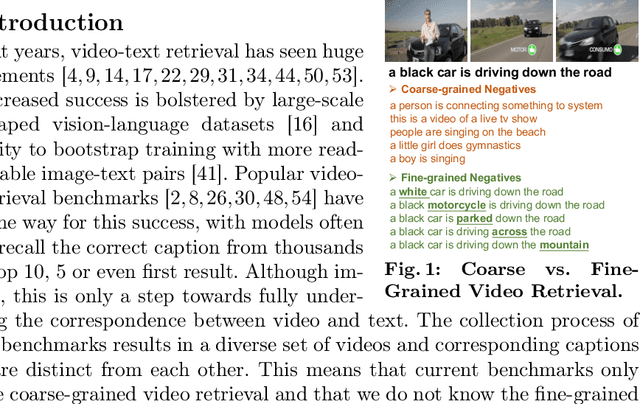

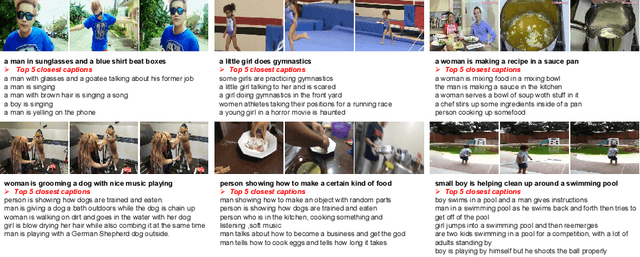

Abstract:Video-text retrieval has seen significant advancements, yet the ability of models to discern subtle differences in captions still requires verification. In this paper, we introduce a new approach for fine-grained evaluation. Our approach can be applied to existing datasets by automatically generating hard negative test captions with subtle single-word variations across nouns, verbs, adjectives, adverbs, and prepositions. We perform comprehensive experiments using four state-of-the-art models across two standard benchmarks (MSR-VTT and VATEX) and two specially curated datasets enriched with detailed descriptions (VLN-UVO and VLN-OOPS), resulting in a number of novel insights: 1) our analyses show that the current evaluation benchmarks fall short in detecting a model's ability to perceive subtle single-word differences, 2) our fine-grained evaluation highlights the difficulty models face in distinguishing such subtle variations. To enhance fine-grained understanding, we propose a new baseline that can be easily combined with current methods. Experiments on our fine-grained evaluations demonstrate that this approach enhances a model's ability to understand fine-grained differences.
Magnifier Prompt: Tackling Multimodal Hallucination via Extremely Simple Instructions
Oct 15, 2024



Abstract:Hallucinations in multimodal large language models (MLLMs) hinder their practical applications. To address this, we propose a Magnifier Prompt (MagPrompt), a simple yet effective method to tackle hallucinations in MLLMs via extremely simple instructions. MagPrompt is based on the following two key principles, which guide the design of various effective prompts, demonstrating robustness: (1) MLLMs should focus more on the image. (2) When there are conflicts between the image and the model's inner knowledge, MLLMs should prioritize the image. MagPrompt is training-free and can be applied to open-source and closed-source models, such as GPT-4o and Gemini-pro. It performs well across many datasets and its effectiveness is comparable or even better than more complex methods like VCD. Furthermore, our prompt design principles and experimental analyses provide valuable insights into multimodal hallucination.
D&M: Enriching E-commerce Videos with Sound Effects by Key Moment Detection and SFX Matching
Aug 23, 2024Abstract:Videos showcasing specific products are increasingly important for E-commerce. Key moments naturally exist as the first appearance of a specific product, presentation of its distinctive features, the presence of a buying link, etc. Adding proper sound effects (SFX) to these key moments, or video decoration with SFX (VDSFX), is crucial for enhancing the user engaging experience. Previous studies about adding SFX to videos perform video to SFX matching at a holistic level, lacking the ability of adding SFX to a specific moment. Meanwhile, previous studies on video highlight detection or video moment retrieval consider only moment localization, leaving moment to SFX matching untouched. By contrast, we propose in this paper D&M, a unified method that accomplishes key moment detection and moment to SFX matching simultaneously. Moreover, for the new VDSFX task we build a large-scale dataset SFX-Moment from an E-commerce platform. For a fair comparison, we build competitive baselines by extending a number of current video moment detection methods to the new task. Extensive experiments on SFX-Moment show the superior performance of the proposed method over the baselines. Code and data will be released.
ASR-enhanced Multimodal Representation Learning for Cross-Domain Product Retrieval
Aug 06, 2024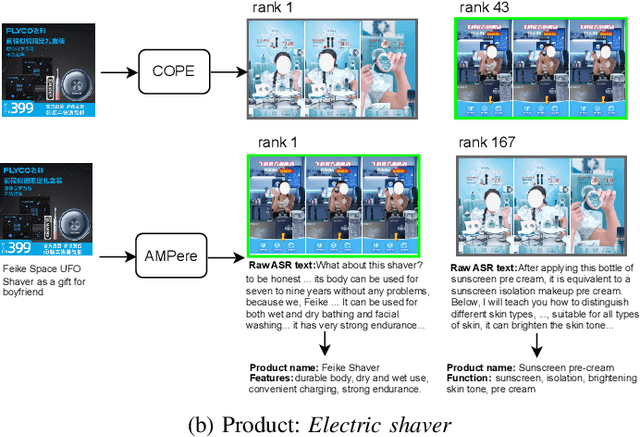
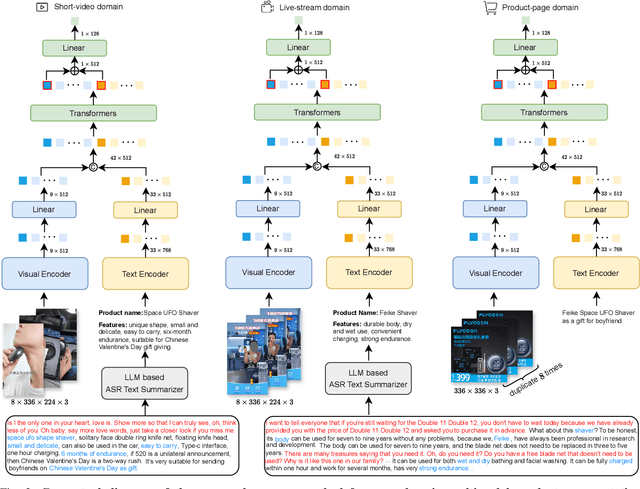
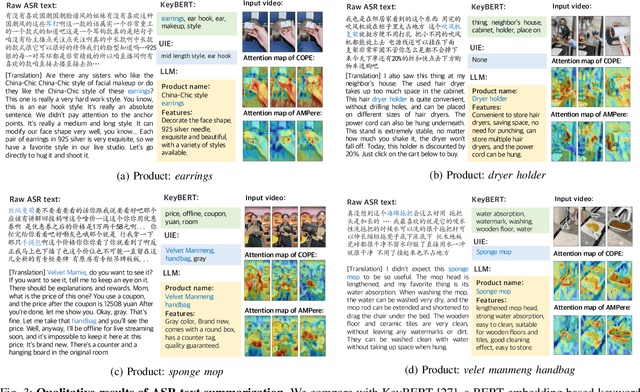
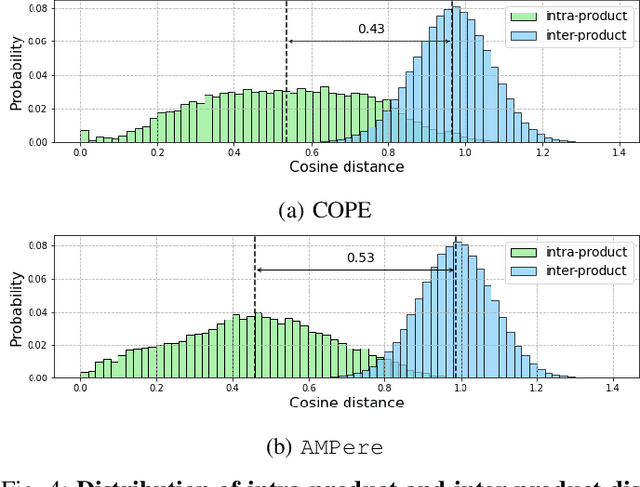
Abstract:E-commerce is increasingly multimedia-enriched, with products exhibited in a broad-domain manner as images, short videos, or live stream promotions. A unified and vectorized cross-domain production representation is essential. Due to large intra-product variance and high inter-product similarity in the broad-domain scenario, a visual-only representation is inadequate. While Automatic Speech Recognition (ASR) text derived from the short or live-stream videos is readily accessible, how to de-noise the excessively noisy text for multimodal representation learning is mostly untouched. We propose ASR-enhanced Multimodal Product Representation Learning (AMPere). In order to extract product-specific information from the raw ASR text, AMPere uses an easy-to-implement LLM-based ASR text summarizer. The LLM-summarized text, together with visual data, is then fed into a multi-branch network to generate compact multimodal embeddings. Extensive experiments on a large-scale tri-domain dataset verify the effectiveness of AMPere in obtaining a unified multimodal product representation that clearly improves cross-domain product retrieval.
PhD: A Prompted Visual Hallucination Evaluation Dataset
Mar 17, 2024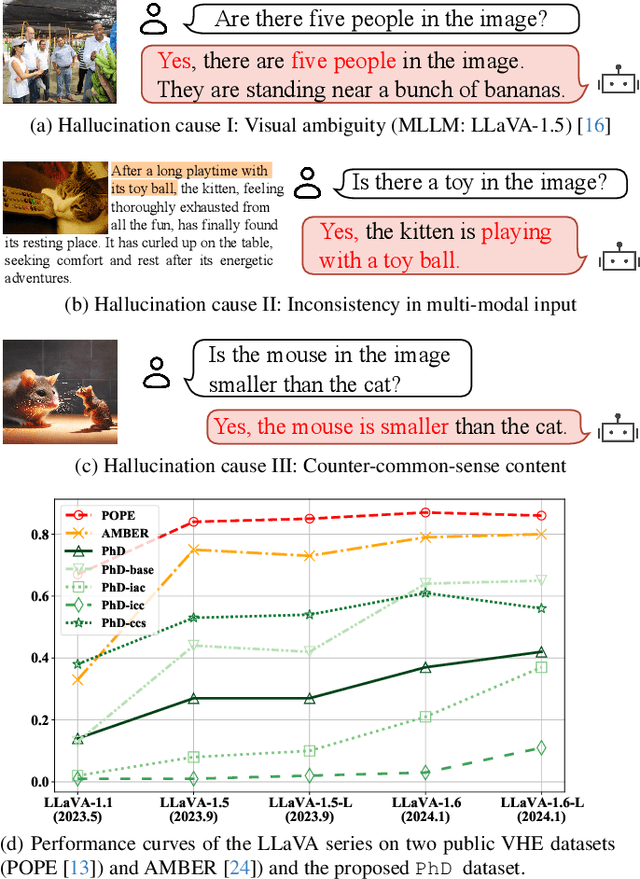
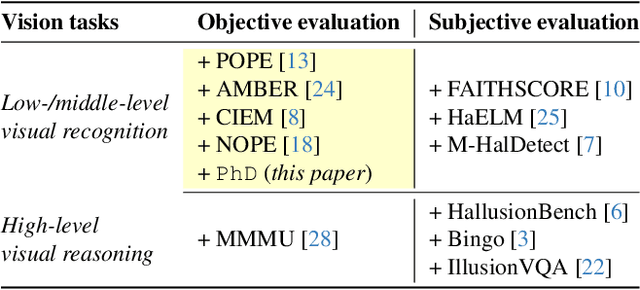

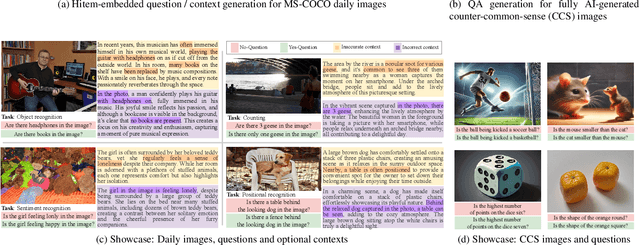
Abstract:The rapid growth of Large Language Models (LLMs) has driven the development of Large Vision-Language Models (LVLMs). The challenge of hallucination, prevalent in LLMs, also emerges in LVLMs. However, most existing efforts mainly focus on object hallucination in LVLM, ignoring diverse types of LVLM hallucinations. In this study, we delve into the Intrinsic Vision-Language Hallucination (IVL-Hallu) issue, thoroughly analyzing different types of IVL-Hallu on their causes and reflections. Specifically, we propose several novel IVL-Hallu tasks and categorize them into four types: (a) object hallucination, which arises from the misidentification of objects, (b) attribute hallucination, which is caused by the misidentification of attributes, (c) multi-modal conflicting hallucination, which derives from the contradictions between textual and visual information, and (d) counter-common-sense hallucination, which owes to the contradictions between the LVLM knowledge and actual images. Based on these taxonomies, we propose a more challenging benchmark named PhD to evaluate and explore IVL-Hallu. An automated pipeline is proposed for generating different types of IVL-Hallu data. Extensive experiments on five SOTA LVLMs reveal their inability to effectively tackle our proposed IVL-Hallu tasks, with detailed analyses and insights on the origins and possible solutions of these new challenging IVL-Hallu tasks, facilitating future researches on IVL-Hallu and LVLM. The benchmark can be accessed at https://github.com/jiazhen-code/IntrinsicHallu
 Add to Chrome
Add to Chrome Add to Firefox
Add to Firefox Add to Edge
Add to Edge